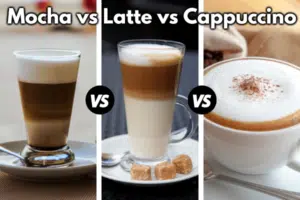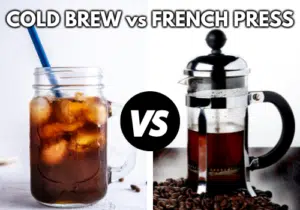How To Grind Coffee For Cold Brew - A Barista Weighs In
Disclosure: This post contains affiliate links and I may earn a small commission (at no extra cost to you) if you click through and make a purchase. Thanks in advance – I really appreciate it!
Grind size – just like the roasting process – greatly affects the taste of your coffee. Using the same type of coffee, you can prepare different coffee specialties – merely by grinding coffee beans more coarsely or finely.
For this reason, choosing the right grinding degree is quite important for maximizing your taste experience. Especially when it comes to cold brew coffee grind size.
Key Takeaways:
What’s the ideal grind size for cold brew coffee?
Cold-brew coffee calls for a medium to coarse coffee grind size. The immersion cold brew method allows for complete saturation of the coffee grinds for an extended period of time. Thereby, the aromas dissolve thoroughly and mildly, which is ideal for coarsely ground coffee.
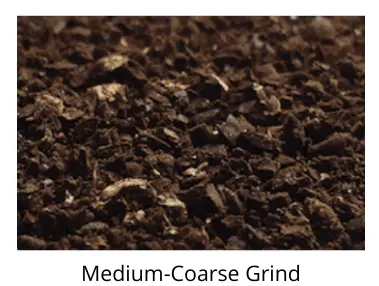
In this article, I am going to help you understand how the ideal cold brew grind size affects the sweet flavors and aromas of your coffee and we will also discuss some of the best methods to achieve that perfect medium to coarse grind size.
The Best Grind Size For Cold Brew Coffee
A medium to coarse grind is the best choice for making cold brew coffee. A fine grind tends to clump together and it also results in too much oil being extracted which will make your coffee bitter. If the grind is ultra-coarse, your drink is going to be weak, watery, and underdeveloped.
Why Is Medium To Coarse Grind Size Best For Cold Brew
A medium to coarse coffee grind size is ideal for a cold brew as it increases the surface area of coffee particles that will come into contact with water during brewing.
The cold-brew immersion method calls for placing coffee grounds in a vat of water and letting them steep for a period of time.
A medium to coarse grind size is best for this process as it allows coffee solubles to be slowly extracted by the water over 6 to 24 hours.
This method creates a super smooth, low acidity coffee with lower flavor notes such as caramel, brown sugar, and cola.
The finer you grind your coffee beans, the more you increase the exposed surface area of the grounds, resulting in faster extraction.
That’s why coffee for espresso machines is ground fine since the water from an espresso maker passes very quickly at high pressure through the grounds.
Just remember this rule of thumb:
The finer your coffee powder, the shorter you should brew it. The coarser your ground coffee, the longer the contact time.
Can I Use Fine-Grind Coffee For Cold Brew?
Fine ground coffee can be used to make cold brews although it might interfere with filtration. To avoid the bitter taste from over-extraction, reduce the time you steep the grounds. Start checking it after 6 hours and then check every 2 hours until it is as strong as you would like.
Any type of cold brew coffee would be predestined for over-extraction if you mixed it with finely ground coffee powder.
This is because, with this method, the coffee powder is exposed to water for a long time. Some cold brew varieties are even immersed in water for hours. Therefore, a coarse cold drip grind size is best for preparing cold-brewed coffee.
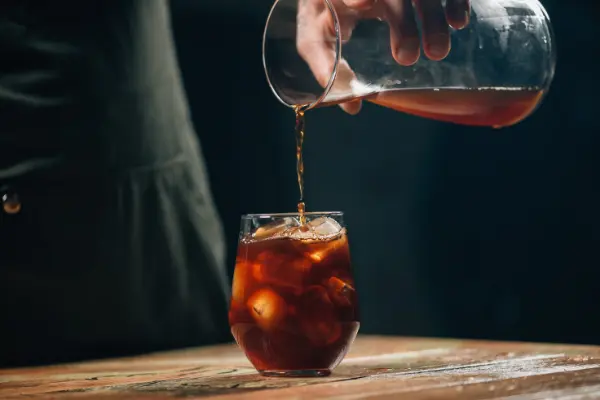
Can I Use Espresso Grind For Cold Brew?
Espresso grind can be used to make cold brew although it might be difficult to filter the finer espresso grinds. To prevent over-extraction of coffee, reduce the time you soak the espresso grinds because the finer coffee grind tends to release its flavors faster than the coarser grinds.
Remember that your goal in choosing a grind size is to extract the perfect amount of flavor from your coffee. Too little and you’ve under-extracted it, too much and you’ve over-extracted it.
If your grinds are too fine like espresso grinds, there is always a risk of your coffee being over-extracted. This is when you have extracted too much flavor out of your coffee – and it becomes overpowering and unpleasant.
Blade Vs Burr Vs Manual Grinder For Cold Brew Coffee
A great coffee grinder has the ability to transform your cold brew coffee experience from the inside out. Your coffee will be more flavorful and delicious. You’ll be able to determine your coffee’s flavor and strength. You’ll be able to brew coffee that rivals your favorite coffee shop
There are generally 3 types of grinders.
- Blade Grinders
- Burr Grinders
- Manual Grinders
Blade Grinders
A blade grinder is a machine that chops coffee beans while mixing them. There is a blade in the center of the grinder that looks like a propeller, similar to a blade in a blender or a food processor. This grinder offers more power for faster grinding, but coffee grounds can be uneven in size.
Uneven grounds can lead to a bad-tasting cup of cold brew coffee because you will taste different flavors of the coffee, like the bitterness from the finely ground coffee paired with the bold flavor of the bigger pieces.
So, a blade grinder is not the best way to grind beans for your cold brew.
Burr Grinders
There are flat burr grinders and conical burr grinders, but they do the same thing: Grind your coffee, and grind it well. The distance between the surfaces can be changed, which in turn will change the size of the grind.
The reason that coffee aficionados tend to choose burr grinders over blade is that the beans are ground in a uniform size, giving you more control over the grind than you do with a blade.
A uniform ground is much harder to do in a blade grinder, especially if you are trying to do a coarser ground, which is why burr grinders are wholeheartedly recommended for anyone doing cold brew or pour overs.
Baratza Encore Conical Burr Coffee Grinder and Cuisinart Supreme Grind Automatic Burr Mill are two of the best-selling burr grinders with a number of grinder settings for all coffee grind sizes, larger grinding burrs, heavier overall weight, and a low-speed grind.
Manual Coffee Grinders
Manual coffee grinders are middle to high performers that produce uniform-sized grounds (which is essential to balance and delicious coffee). They can do this consistently for all grind sizes, from Cold brew, French press to espresso, though there aren’t always many grind size settings for micro-adjustments.
You’ll quickly notice that manual coffee grinders can be quite small. Most can be held with one hand, and cranked with the other. If portability for travel brewing is high on your list of values, this is a huge win for manual grinders.
JavaPresse Manual Coffee Grinder comes equipped with over 18 manual grind settings to ensures you have 100% precision & control over the coarseness of your grind.
Popular Burr Grinder Settings For Cold Brew
Below is a table of cold brew grinder settings of the most popular grinders that are available in the marketplace today.
| Grinders | Grind Setting |
|---|---|
| Baratza Encore | 31 – 40 |
| Baratza Virtuoso | 31 – 40 |
| Baratza Vario | 8 – 10 |
| Capresso Infinity | 12 – 16 |
| Cuisinart Supreme Grind | 14 – 18 |
| Bodum Bistro | 11 – 14 |
| OXO Brew Burr Grinder | 11 – 15 |
| Hario V60 | 34 – 44 |
| KRUPS Burr Grinder | 13 – 17 |
How To Grind Coffee Beans If You Don’t Have A Grinder
With some simple kitchen tools and a little elbow grease, you can easily replicate the texture and consistency of cold brew coffee grounds produced by a grinder without having to run out and buy one before breakfast.
Use a Blender
Using a blender is an easy way to grind your beans to a good consistency. But, keep this in mind: there’s no way to make the grounds the same size. You’ll still get a usable consistency, though.
Some blenders may have a “grind” setting, but if they don’t, not to worry! You’ll want to make sure you use a “pulse” setting, or manually blend the beans yourself.
Use a Mortar & Pestle
this method may take a while, but it should work. Start with just a few beans at a time and add more as you go.
Once crushed, use the pestle to roll the coffee around the bowl, until you see the consistency and texture you want.
If you need to grind more coffee, empty the coffee you’ve already ground into a bowl (or your coffee maker) and repeat the process till you have enough coffee for your cold brew.
Use a Food Processor
Similar to the blender, this is one of your best options. This won’t be as good as a regular coffee grinder, of course, but when you’re in a pinch, this method is good enough.
You’ll get similar results to the blender but you’ll require more beans since the circumference of the food processor is usually wider than that of a blender.
Use a Hammer
Put beans in a high-quality plastic freezer bag, then put that package between towels. Then use a meat-tenderizing mallet or regular old hammer to crush the beans.
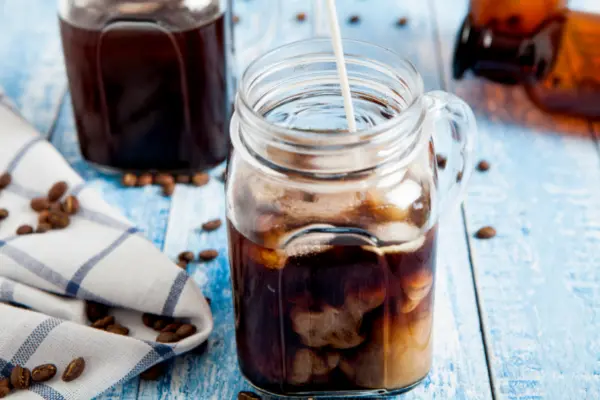
How To Make Cold Brew Coffee
Making cold brew coffee is no great secret, nor does it require the ninja-level skills of a trained barista in order to master. You don’t even need much special equipment beyond a large container for making the coffee and a strainer.
Though stronger than drip coffee, cold brew actually contains less caffeine. The oils and sugars are extracted during the steeping process, and this creates a stronger flavor than traditional coffee methods.
What you’ll need:
- 3 ounces coarsely-ground coffee
- 3 cups of water
- One quart container
- Paper coffee filter
- Glass Carafe
Step 1: Grind your coffee
Grind the coffee coarsely, which you can do yourself at home or wherever you buy the beans.
Step 2: Soak the grounds
In a one-quart (or one Liter) container add the coffee grounds and pour filtered water over the grounds.
Gently, using the back of a spoon, submerge the grounds just so they are all below the surface of the water. No need to stir.
Step 3: Let it steep
Place the container in the fridge for twelve to fourteen hours. Don’t forget to lid your container to avoid absorbing any other aromas.
Step 4: Filter your coffee
Set a fine-mesh strainer over a spouted container and insert a coffee filter. Give the coffee a stir, then pour the coffee and grounds into the filter allowing the filter to capture the grounds and strain into the spouted container.
Gently use a spatula to move the grounds around, and make way for the coffee.
Step 5: Enjoy your cold brew
Discard the filter in your compost bin or garden and transfer the cold brew to a mason jar or glass carafe. Before serving, top with cream, milk, or simple syrup to taste.
How to Make Cold Brew Coffee in a French Press
What you’ll need:
- 6 oz. (About 3/4 cup) of coarsely ground coffee
- 28 oz. cold water
- French press
Place the grounds in the base of your French Press and cover with cold water. Don’t push down your French Press plunger just yet, and place your French Press in the fridge for twelve to fourteen hours. Don’t forget to cover your French Press to avoid absorbing any other aromas.
Then, push down your plunger and pour over ice. Add milk, flavoring, or simple syrup if desired.

Amit Gupta
Hi, my name is Amit Gupta, and I am the owner and contributor at Cafeish. My obsession with coffee started when I received my first French press as a gift almost ten years ago. Since then, my love of coffee – and the number of coffee gadgets I own – has grown considerably.
Most Popular
ABOUT US
We are a team of coffee affcianados with experience and expertise in making world renowned coffee. In fact, preparing the best coffee ever with a fluffy top reminds us of magic, with secrets of how to achieve each particular effect. Making coffee is not our only hobby, we always keep our ears open as to what’s happening around and what scientists and manufacturers produce for consumers. It’s not an easy task to do – it’s rather time consuming. Hence, Caféish website was launched.
LEGAL DISCLAIMER
Caféish is a participant in the Amazon Services LLC Associates Program, an affiliate advertising program designed to provide a means for sites to earn advertising fees by advertising and linking to Amazon.com. Caféish also participates in affiliate programs with Clickbank and other sites. Caféish is compensated for referring traffic and business to these companies.

